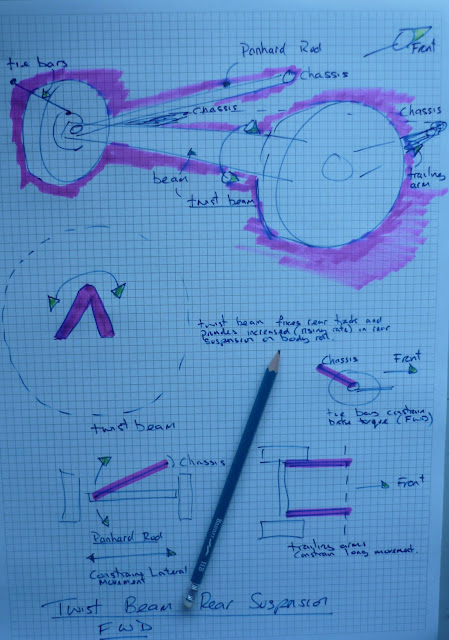
We think about suspension a lot - even if we don`t always realize it. How comfortable our vehicle is and how soft or hard the ride; how it handles and how it drives through bends; how safe it feels and how much the body rolls; and, of course, how it deals with load. But what we don`t always appreciate is the other job suspension has to do. A vehicle`s suspension system is not just about springs and dampers – it`s also about location.
All wheels have to be located. Not rigidly fixed in position like the crude wooden circles on a medieval cart; but constrained to work within parameters. Wheels will move backward and forward and up and down as the suspension deflects. Wheels arc in camber and attempt to twist their hubs and axles with brake and drive torques. As the vehicle corners, tyres and components play with alignment and force wheels to toe. Cornering also tries to make them shift sideways. To combat all these forces we have the suspension system.
To allow the suspension to work, the axle or wheel has to move in relation to the chassis. For this to happen, while maintaining vehicle stability, wheels are constrained to work within a range of movement - a movement that will affect directional control. Below are some thoughts on how it works with (mainly) rear suspension.
· (conventional) leaf spring suspension does it all – suspension and location
· the front half of the leaf can be considered a trailing arm – it straightens on deflection, extending wheel base on that side of the chassis
· swinging shackles are found at the rear of the spring – the wheel drives and brakes through the front, fixed shackle
· all rear suspension effects directional control
· trunnion bearing leaf spring suspension and transversely mounted leaf springs (front Merc Sprinter – rear triumph Spitfire) do not locate wheels/axles
· parallel link or McPherson Strut independent suspension constrain wheels with triangulated lateral links (and strut in case of Mc Pherson) – in truth, Mc Pherson struts are only used on front suspension systems, as they are designed to turn with the steering but the strut and lower link locating principle also works at the rear
· semi-trailing links (BMW) cause camber and toe changes when they change position – set up angle is important and can be altered if ride height is changed
· air springs and coil springs have no locating strength
· trailing links and torque bars provide constraint
· axle attachment is important – on trailers, substantial U-bolts and trailing arm bushes constrain wheel alignment and lateral movement
· some trailers use monocoque axles, using tri-functional bushes to mount trailing arm to chassis – its purpose is to act as a mounting bush (arm rotates on it), provide alignment constraint (steer), and increase suspension stiffness in roll
· twist beam rear axles on some cars (Nissan, VW Passat, Ford KA, to name only a small number that use this technology), will use lateral stability link if the beam is at the rear of trailing arms – usually some sort of Panhard Rod
· tie bars are sometimes used to absorb brake torque
 |
| Usually called `degrees of freedom`, a wheel can move in a number of directions |
 |
| Leaf springs do it all - suspension and location (side view) |
 |
| Under deflection, leaf springs act like trailing arms, steering vehicle from the rear (top and rear views) |
 |
| As spring straightens, wheel base extends (side view) |
 |
| Air springs have no locating strength (angled view from rear right) |
 |
| Trailing links (arms) and torque bars locate the axle (top view) |
 |
| All wheels have to be located. Struts and lateral links constrain the wheel using McPherson principle (angled view) |
 |
| Wheel is constrained using triangulated link and strut. Top thrust bearing is used on (front) steered wheel (top, front and side views) |
 |
| Twist beams are common on light, FWD cars |
 |
| Twist beams increase suspension stiffness in roll - they can cause camber change (angled view from rear right) |
 |
| Most cars use beams mounted at front of trailing arms - if not, stabilizing (lateral) link is needed (rear and top view) |
No comments:
Post a Comment